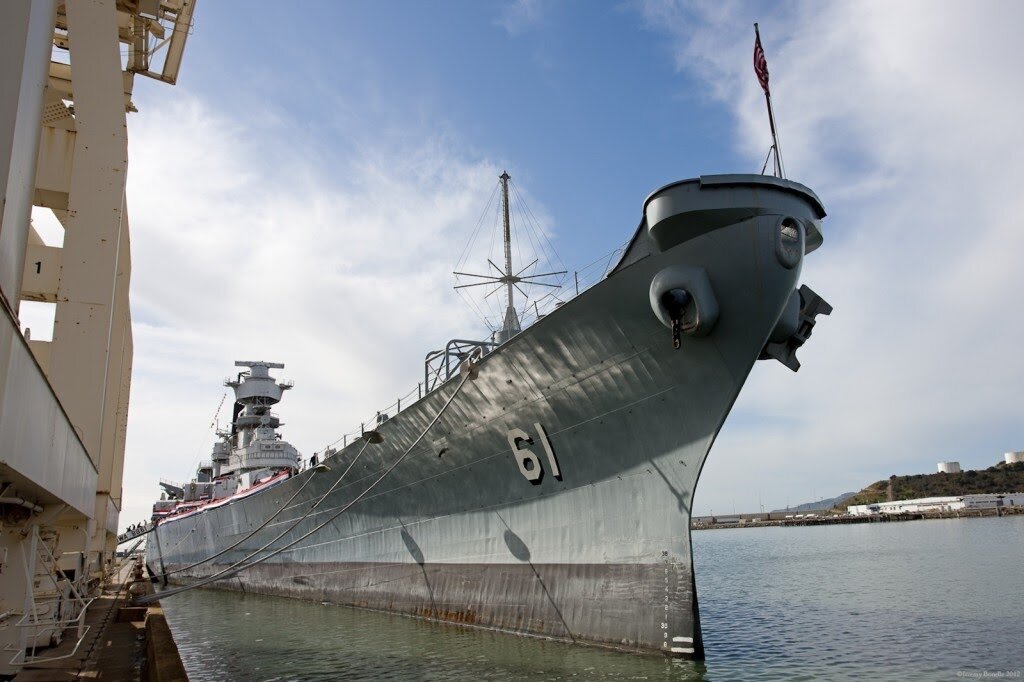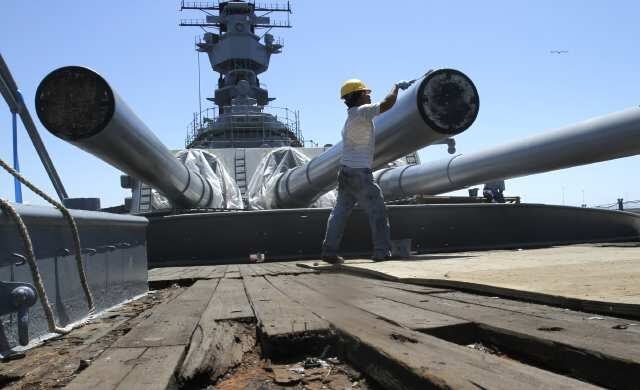Our History and Heritage – The Battleship of Presidents the USS Iowa
Our History and Heritage – The Battleship of Presidents the USS Iowa
In the fall of 2011, Jonathan Williams and Mike Getscher found themselves alone on an 887-foot steel behemoth they had just helped rescue from exile in the Suisun Bay Naval Reserve Fleet - the so-called “ghost fleet.” That vessel was the grande dame of United States battleships - the venerable USS Iowa (BB-61).
Towed to a lonely dock in Richmond, CA, the storied ship had no power, no water, no facilities of any sort, no computer infrastructure, no tools, and no personnel to do the work to transform her into a museum, community platform, and educational institution, moored alongside a pier in the largest harbor complex in the country, the Port of Los Angeles.
As Williams and Getscher, who would go on to become CEO and COO respectively of Pacific Battleship Center, the 501c3 non-profit that currently owns Battleship IOWA, walked decks that had seen visits by three U.S. presidents and peeked into compartments where history had been made - the D-Day invasion was planned aboard the ship in 1943, the true scope of the endeavor before them hit full force.
Though the ship’s overall structural integrity was incredibly sound, twenty-years of retirement manifested themselves as rot on IOWA’s once-proud teak decks and rust on her towering superstructure. The challenges went deeper than the surface grime.
The organization had maybe two weeks worth of cash in the bank, no credit history, no vendor accounts, no employees - and no way to pay them if it did. They were 450 miles from the proposed location of their business, in a town where no one knew who they were or what they did. The governmental jurisdiction that would be their future landlord didn’t want them, didn’t believe they’d make it, and hadn’t signed a lease with them. They needed fifty to one hundred people to get to work on the project right away…
The list of reasons they could fail was daunting. The list of reasons they had to succeed was more important.
Against those tremendous odds, succeed they did. The State of Iowa provided $3.5 million to aid in the restoration, other donors came forward, and IOWA herself became a magnet, luring in a family to care for her.
As soon as the Bay Area discovered the battleship was looking for help, people came out in droves. Within weeks the rapidly growing organization was hosting over a hundred volunteers, keen to leave their marks in the great ship’s annals: former crew members who wanted to take care of their girl, battleship aficionados who longed somehow to work aboard a capital ship and finally had a way to fulfill that dream, and ordinary citizens looking for a way to contribute to something extraordinary. All of them came together to support a project they believed in.
They chipped rust, painted, welded, got into filthy-dirty, cramped, tiny places, and created memories that will last a lifetime. In May 2012 the risk and the hard work paid off when the battleship was towed to Southern California.
She opened to the public in July of that same year, and has since drawn nearly two million visitors to make her a Top 5 TripAdvisor attraction.
The ship’s ability to inspire enabled the organization to begin to plan its next step: a transition to become the National Museum of the Surface Navy - one of few national-level museums in California. That aim of course was disrupted by the pandemic, which once again tested the organization's mettle. As she always has, the IOWA weathered the storm and is back on track to open the Surface Navy Museum by 2025.
Rear Admiral (ret.) Mike Shatynski, the chairman of IOWA’s board, himself a former battleship sailor, describes the new museum in this video.
IOWA’s teak decks and steel bulkheads echo the words and deeds of history, having carried upon them three U.S. Presidents, six of the nine American five-star military leaders, countless foreign dignitaries, and thousands of her own heroic IOWA sailors. Visitors are awed by the IOWA’s sheer size as well as her proud legacy as one of the fastest and most powerful ships to ever sail the world’s oceans.
Open 363 days a year from 10 AM - 5 PM, the IOWA is a must-see in Los Angeles. Tickets may be purchased in person or online. Be sure to check out virtual offerings as well, especially for students.
You can join the effort to bring the National Museum of the Surface Navy to life by becoming a “plank owner” today. It’s free and comes with fun perks!
The mission of the Pacific Battleship Center (PBC) is to celebrate the American spirit through the preservation and interpretation of the Battleship IOWA, to educate the public on the accomplishments and sacrifices of American patriots, and to engage guests in unique and exciting ways that bring the ship to life by connecting the past with the present and the future. As a historic naval ship museum, we inspire civic engagement through Education, Veterans, and Community efforts - our three core pillars.
Entering service over seventy-eight years ago, the USS Iowa deployed to the South Pacific in World War II. The iconic battleship served with distinction in that war, and later during the Korean War. In the 1990s, as the Berlin Wall crumbled, Iowa concluded her active duty. Battleship USS IOWA now serves as a 501c3 non-profit historic naval ship museum and is supported solely by earned revenues, individual donations, corporate foundations, and philanthropic organizations. Forged in war and a guardian of peace, the proud ship is the sentinel of the Los Angeles Waterfront.









